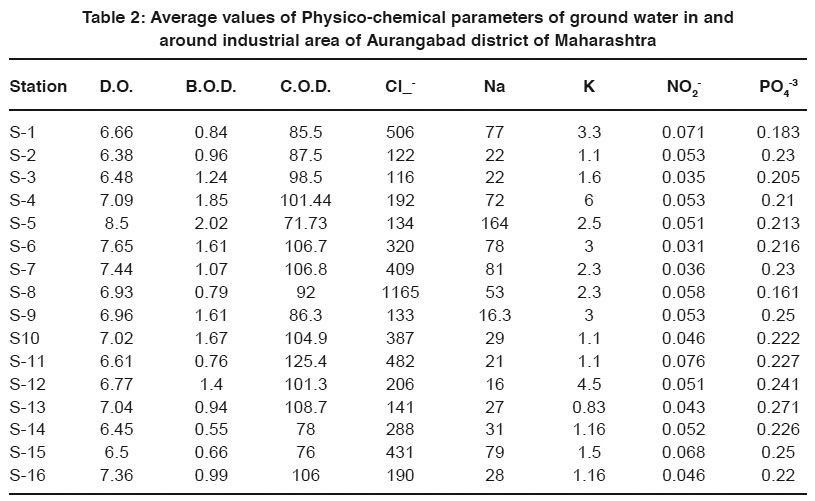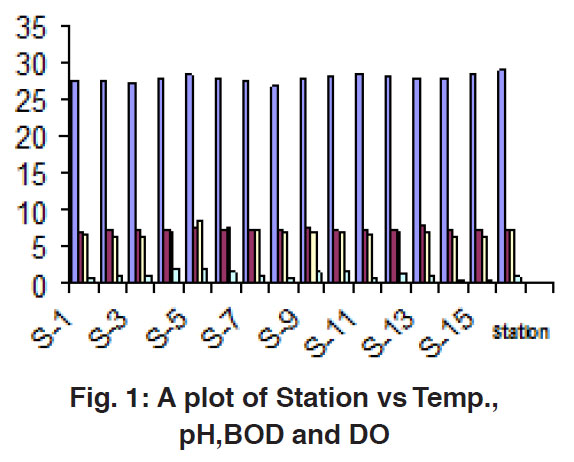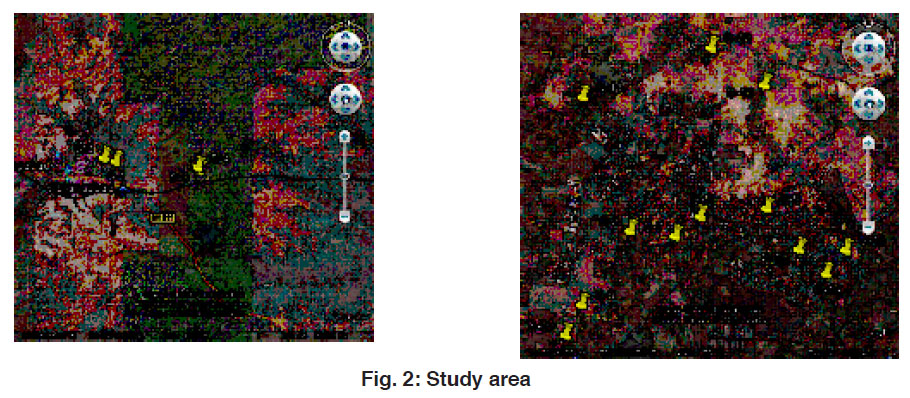Evaluation of borewell water of various places located in and around industrial area of Aurangabad district of maharashtra
Sumant B. Bikkad1 , Sunil R. Mirgane1 and Aravind R. Mahajan1 *
1
Depatment of Chemistry,
J.E.S. College,
Jalna,
431 203
India
DOI: http://dx.doi.org/10.12944/CWE.3.1.15
Present investigation deals with the study of borewell water samples in and around the industrial area of Aurangabad district of Maharashtra, used for various domestic uses. Physico-chemical parameters of selected borewell waters were evaluated indicates that water samples are polluted, maximum of samples have E.C., TDS, Hardness, Ca++, Mg++ and COD values exceeding the permissible limits for drinking purpose. It is observed that the main sources of pollution are due to industrial waste water, municipal sewage, lack of sanitation and presence of inorganic constituents in the waste water.
Copy the following to cite this article:
Bikkad S.B, Mirgane S.R, Mahajan A.R. Evaluation of borewell water of various places located in and around industrial area of Aurangabad district of Maharashtra. Curr World Environ 2008;3(1):115-118 DOI:http://dx.doi.org/10.12944/CWE.3.1.15
Copy the following to cite this URL:
Bikkad S.B, Mirgane S.R, Mahajan A.R. Evaluation of borewell water of various places located in and around industrial area of Aurangabad district of Maharashtra. Curr World Environ 2008;3(1):115-118. Available from: http://www.cwejournal.org/?p=775
Download article (pdf) Citation Manager Publish History
Select type of program for download
| Endnote EndNote format (Mac & Win) | |
| Reference Manager Ris format (Win only) | |
| Procite Ris format (Win only) | |
| Medlars Format | |
| RefWorks Format RefWorks format (Mac & Win) | |
| BibTex Format BibTex format (Mac & Win) |
Article Publishing History
| Received: | 2008-04-08 |
|---|---|
| Accepted: | 2008-05-21 |
Introduction
Aurangabad district of Maharashtra has four main industrial areas Chikalthana, Waluj, Shendra and Paithan. These area posses large numbers of industrial units. Due to rapid industrialization at Aurangabad, large quantity of industrial waste are generated which contains toxic pollutants1 deteriorates the quality of water. Industrial units specially chemical manufacturing whose untreated and partially treated effluents are discharged to different nallah, through small stream or gutter. Through this process there is chance that waste water may perculate in the soil and contaminates ground water2 in and around the industrial area.
Any change in physico chemical characteristic of water not only alters its quality but also disturb its environment.3-4
Chikalthana, waluj and shendra industrial zones were selected for the purpose of investigation. Many illiterate workers live near the industries and use borewell water for there domestic activities. Some time they use this water for drinking purpose. It was worth examining these water resources for various water quality parameters and ascertain their quality with respect to drinking water.
Material and Methods
Sampling stations were located in the nearby small industrial zones and were selected as representative for the entire industrial zone. Samples were drawn from sixteen different borewell during the first week of every month and preferably in the morning hours. Two liters of sample was collected from each sampling station in a polythene container previously washed with 6N Nitric acid.
 |
Table 1: Average values of Physico-chemical parameters of ground water in and around industrial area of Aurangabad district of Maharashtra Click here to view table |
Samples were analyzed for three month i.e. July, August and September 2007 for sixteen different water quality parameters as per standard procedure.5-6 All chemicals and reagents used in the study were of analytical grade procured from S. D. Fine, India, B.D.H. India and Renkem India. Pyrex Glass were used for processing of samples, dilutions and making up of volume etc. double distilled water made in glass apparatus was used throughout the work.
The parameters selected for analysis were temperature, pH, conductivity, total dissolved solid, alkalinity, hardness, Ca++, Mg++, Na+, K+, Cl-, NO2 PO4+-,dissolved oxygen, chemical oxygen demond and biological oxygen demond. pH was measured by LI-120 (Elico) pH meter, D.O. by Wrinkler method, BOD by five day incubation at 20°C, Na and K by Flamephotometer, Nitrite and phosphate by spectrophotometer.
 |
Table 2: Average values of Physico-chemical parameters of ground water in and around industrial area of Aurangabad district of Maharashtra Click here to view table |
Sampling Sites are
S - 1 Power loom area Chikalthana MIDC
S - 2 Deogiri Chemicals Chikalthana MIDC
S - 3 Near Skoda Auto India, Shendra MIDC
S - 4 Shendra Villege, Shendra MIDC
S - 5 Infront of sterlite industry Waluj MIDC
S - 6 Ranjangaon Main Road, Waluj MIDC
S - 7 Hanuman Nagar, Ranjangaon, Waluj MIDC
S - 8 Zilla Parishad Primary School, Ranjangaon, Waluj MIDC
S - 9 Ambedkar Nagar, Jogeshwari, Waluj MIDC
S - 10 Jogeshwari Villege, Waluj MIDC
S - 11 Dhanegaon Near Good Year Tyre, Waluj MIDC
S - 12 Sajapur, Near Paschim Chemical, Waluj
MIDC
S - 13 Wadgaon, Chatrapati Colony, Waluj MIDC
S - 14 Pandharpur Gram Panchayat, Waluj MIDC
S - 15 Pandharpur Near Bajaj Auto, Waluj MIDC
S - 16 Wadgaon slum area Waluj MIDC.
 |
Figure 1: A plot of Station vs Temp., pH,BOD and DO Click here to view figure |
Results and Discussion
Values reported in Table 1and 2 are the average of three months analysis performed for every sample collected in July to September 2007.Temperature was varying within 26.9 to 29°C. Heat released by decomposition of organic matter slightly raised the temperature of polluted water. pH plays a major role in most of chemical and biological reactions.7 All samples found to be alkaline with pH value range 7.03 to 7.82.It is correlated with its bicarbonate content. But pH values are within admissible limit.
 |
Figure 2: Study area Click here to view figure |
Higher values of conductivity and TDS indicate the presence of more dissolved solids in the samples. E.C. values are 763 to3167µs/cm and that of TDS 432 to 1942 mg/L which are above permissible limit. High TDS may leads to imparment in physiological process in human body. Higher alkalinity 263 to 424 mg/L indicates that the presence of bicarbonate and hydroxide salt. Water of all sampling sites is very much hard with reference to hardness ranges from 384 to 1829 mg/L, abnormal values of hardness are due to discharge from chemical industry.8
The ground water is normally saturated with 7.6mg/L of dissolved oxygen at 30°C. DO determine the quality of drinking water ,it gives aesthetic taste to it. The value of DO depends on physical, chemical and biological activity of water sources.9 The DO level of water samples is 6.38 to 8.5,which is within permissible limit.BOD values are less, ranges from 0.55 to 2.02 mg/L are also within limit.
For good quality of drinking water, the tolerance limit for COD is 10 mg/L. The water samples from all the stations indicate that water has very high values of COD, these values are 71 to 125 mg/L, much above the limiting values indicating danger for domestic10 use.
Chloride ion concentration 112 to 1165 mg/ L The higher chloride ion concentration11 is an indicator of pollution by sewage which is highest at S-8 site.
Calcium has no hazardous effect on human health. Higher concentration of Ca++ may be due to leaching of soil. Magnesium is non-toxic element. However portable water having concentration greater than 50 mg/L, exerts laxative effect. High concentration is found at S-1and S-8. sites. Sodium is an essential element but may adversely affect people with cardiac renal & circulatory problem. In present investigation, it is found to be 16 to 164 mg/L. maximum concentration is found at S-5 site. Results recorded in table no 2 shows that all samples have potassium less than 6 mg/L which is below the harmful limit.
The highest concentration PO4-3 ( 0.271 mg/L)have been recorded in S-13 station. The PO4-3 alone is not harmful to man ,but in association with high value of calcium may cause kidney stone. Nitrites are genrally formed in water due to bacterial action on ammonia and oganic nitrogen. All samples found to be less nitrite concentration.
Conclusion
Borewell water samples under investigation are generally uses for domestic purpose and only sometime for drinking purpose. But looking at the results obtained, it can be concluded that borewell water is contaminated and should not be used for drinking purpose without pretreatment.
Acknowledgements
The Author take this opportunity to thank Dr. R. S. Agrawal Principal, Dr. S. M. Deshpande, Head P.G. Dept. of chemistry,J.E.S.college, Jalna for providing laboratory facility.
References
- T. G. More, R. A. Rajput, N. N. Bandela Poll Res. (2005) 24(3): 709-714.
- M. B. Ubale, Faroqqui Mazber, Arif Pathan md., Zaheer Ahamed, Dhule D. G. Oriental Journal chemistry, (2001) 17(2): 347-348.
- C. Borber, C. J. OHO and L. F. Bates, J. Hydrology, (1996) 4, 6.
- C. Subbarao, N. V. Subbarao and S. N. Chanadu, Enviro. Goel. (1996) 28: 175.
- APHA., Standard methods for examination and water and waste water, 19th Ed. AWWA, WPCE, Washington, D. C. 2005. U S A (1995).
- Manivasakam N., Physico chemical examination of water sewage and industrial effluents. Pragati prakashan, meeret. (India) (1996)
- Trevadi R.K. and Goel P. K., Chemical and Biological methods for water pollution studies, environmental publication, Karad. (India) (1986).
- C. Kandeepan and Balasubramanian. J. Ecotoxical Environ. Monitor, (1992) 2: 153.
- M. Z. Hassan and S. P. Pande, J. Indian Water Works Associ. (1993) 16: 256.
- Rajalakshmi S. and K. Sreelatha, J. Aqua, Biol. (2005) 20(2): 110-112.
- O. P. Sharma, K. S. Bangar, Rajesh Jain and P. K. Sharma, Res. J. Chem. Environ. (2004) 8(2).







